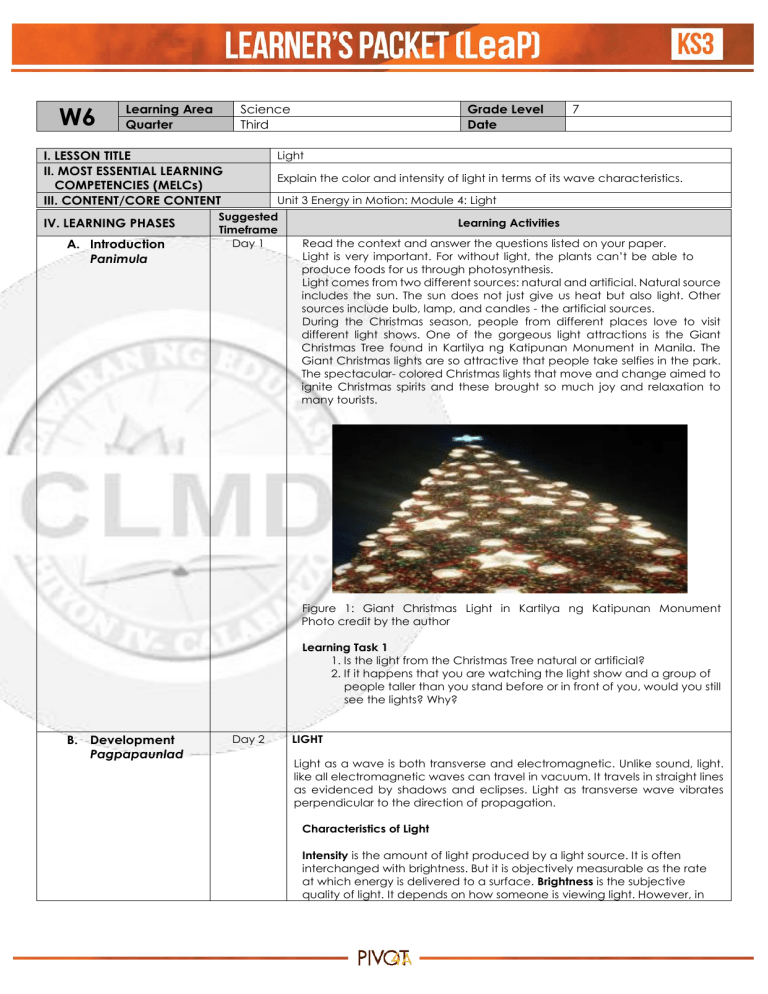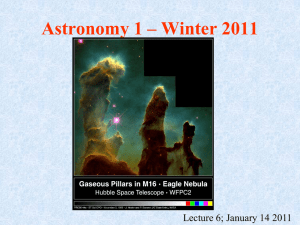
W6 Learning Area Quarter Science Third I. LESSON TITLE II. MOST ESSENTIAL LEARNING COMPETENCIES (MELCs) III. CONTENT/CORE CONTENT IV. LEARNING PHASES A. Introduction Panimula Grade Level Date 7 Light Explain the color and intensity of light in terms of its wave characteristics. Unit 3 Energy in Motion: Module 4: Light Suggested Timeframe Day 1 Learning Activities Read the context and answer the questions listed on your paper. Light is very important. For without light, the plants can’t be able to produce foods for us through photosynthesis. Light comes from two different sources: natural and artificial. Natural source includes the sun. The sun does not just give us heat but also light. Other sources include bulb, lamp, and candles - the artificial sources. During the Christmas season, people from different places love to visit different light shows. One of the gorgeous light attractions is the Giant Christmas Tree found in Kartilya ng Katipunan Monument in Manila. The Giant Christmas lights are so attractive that people take selfies in the park. The spectacular- colored Christmas lights that move and change aimed to ignite Christmas spirits and these brought so much joy and relaxation to many tourists. Figure 1: Giant Christmas Light in Kartilya ng Katipunan Monument Photo credit by the author Learning Task 1 1. Is the light from the Christmas Tree natural or artificial? 2. If it happens that you are watching the light show and a group of people taller than you stand before or in front of you, would you still see the lights? Why? B. Development Pagpapaunlad Day 2 LIGHT Light as a wave is both transverse and electromagnetic. Unlike sound, light. like all electromagnetic waves can travel in vacuum. It travels in straight lines as evidenced by shadows and eclipses. Light as transverse wave vibrates perpendicular to the direction of propagation. Characteristics of Light Intensity is the amount of light produced by a light source. It is often interchanged with brightness. But it is objectively measurable as the rate at which energy is delivered to a surface. Brightness is the subjective quality of light. It depends on how someone is viewing light. However, in IV. LEARNING PHASES Suggested Timeframe Learning Activities the quantitative aspect, brightness is expressed in a unit called candela. White light undergoes dispersion through a prism. Dispersion is a phenomenon in which white light separates into its component colors. It was discovered by Sir Isaac Newton during 1666. Christian Huygens postulated that the more light was “bent” or refracted by a “substance” or material, the slower it would move while traversing across that material. Max Planck postulated that electromagnetic radiation is a form of energy with both wave-like and particle like properties. Visible light is part of this radiation and can be described in terms of its frequency and wavelength. The theory of electromagnetic radiation was demonstrated by James Clerk Maxwell that electric and magnetic fields travel though space as waves moving at the speed of light. Figure 2: Dispersion of Light in a Prism Photo credit by the author The seven colors include red, orange, yellow, green, blue, indigo and violet which are also known as ROYGBIV or the colors of the rainbow. Among the seven colors, violet has the highest frequency but the shortest wavelength. While red has the lowest frequency but the longest wavelength. It is obvious here that the frequency of light is indirectly related to the wavelength. As the frequency increases, the wavelength decreases. These are the reasons why red colors have been used mainly as color in various commercial logos. C. Engagement Pakikipagpalihan Day 3 The color of the object we see depends on the light reflected (in the case of opaque materials) or transmitted (in the case of transparent materials) that reaches our eyes. Recall that the visible spectrum consists of different frequencies, each corresponding to a particular color. For example, a green leaf appears green because when light from the sun shines upon it, the leaf absorbs all the frequencies of the visible light spectrum except for the green. Thus, a “green” leaf will be seen. Learning Task 2: Determine which frequency of light will be reflected and what color will be seen by the observer. Suggested Timeframe IV. LEARNING PHASES Learning Activities The roof reflects _______________. The roof appears _______________. The roof reflects _______________. The roof appears _______________. Day 4 D. Assimilation Paglalapat Learning Task 3: Complete the statement by writing the appropriate word in the blank. Max Planck explained that light can be a particle and a wave. Light exhibits various characteristics. As a wave, it is a ________ wave in terms of direction of vibration and propagation. ________ of light depends on the source and the distance from the source. This is expressed in the unit of ________. The electromagnetic waves are arranged in the electromagnetic spectrum according to increasing ________. Among the waves, the perceptible wave is the visible light. Visible light is composed of different colors abbreviated as ________, also known as the colors of the rainbow. This has been proved by Sir Isaac Newton in which he used a prism to separate white light into its component colors. This phenomenon is called ________. The color of an object we see depends on light ________ or ________. Learning Task 4 Light has proven its integral part in our life. For without light, everything will be pure darkness. In the book of Genesis, the Lord noticed that everything was dark and he said, “Let there be light.”, and there was light. In the book of Matthew, it is stated that “You are the light.” What does it mean to be a light in the world? V. ASSESSMENT (Learning Activity Sheets Enrichment, Remediation for or IV. LEARNING PHASES Suggested Timeframe Learning Activities Assessment to be given on Weeks 3 and 6) VI. REFLECTION Prepared by: WENDY P. VILLANUEVA The learner communicates the explanation of their personal assessment as indicated in the Learner’s Assessment Card. The learner, in their notebook, will write their personal insights about the lesson using the prompts below. I understand that ___________________. I realize that ________________________. I need to learn more about __________. Checked by: ANTONIO A. PETILOS REA C. BUNAN MARIFE A. SIOSON SHIRLEY FERRERA References: Castro, Chonalyn V., Freed Module, Grade 7 Quarter 3 Module 4 Asuncion, Alvie et al. 2012. Science Learner’s Material, Department of Education






